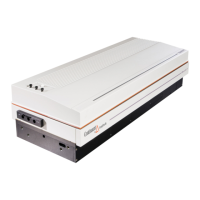Chapter II – System Operation
2-13
C
996-0255 rev. b
5) Begin sending pulses to the EXT flashlamp trig in BNC at the normal
repetition rate of the Precision II. These fire flashlamps signals should
start the flashlamps.
CAUTION:
Do not exceed the nominal repetition rate of the laser.
Lensing effects from higher repetition rates can damage
laser optics.
6) Now start sending pulses to the Q-switch trigger TTL BNC. Initially
send these Open Q-switch signals ~200 µs after each fire flashlamp
signal.
7) Press the SHUTTER button on the RB601 and verify that the shutter
LED is on. The Precision should now output laser pulses ~80 ns after
each open Q-switch signal, depending on the laser’s buildup time
(BUT).
8) Adjust the timing delay between the flashlamp fire and open Q-
switch pulses for maximum (or any desired) laser energy.
Note:
An additional signal to start the flashlamp capacitor
banks recharging is not necessary in DAT mode.
2) Stanford Research Pulse Generator setup
Directions for External Triggering Precision II using a Stanford Delay
Generator Mdl#DG535.
It is not possible to externally trigger the flashlamps and have the laser
internally trigger the Q-switch. You must provide both a lamp fire and
Q-switch fire command.
Materials required
1 ea. Stanford Delay Generator MDL# DG535
2 ea. Standard BNC cables.
Procedure:
1. Program the DG535 as follows:
a) TRIGGER - set to Internal and desired reprate (10, 20, 30
or 50 Hz)
b) OUTPUTS - set all outputs to High Z, TTL and NORMAL

